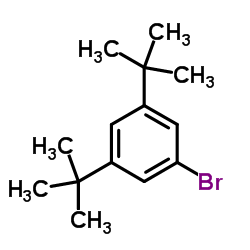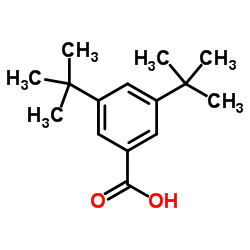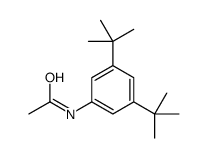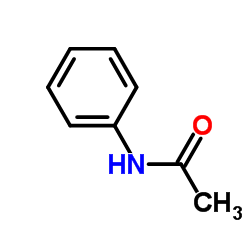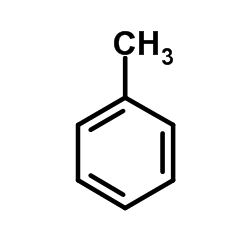2380-36-1
| 中文名 | 3,5-二叔丁基苯胺 |
|---|---|
| 英文名 | 3,5-ditert-butylaniline |
| 英文别名 |
3,5-Di-tert-butylaniline
MFCD00134096 EINECS 219-173-0 3,5-Bis(2-methyl-2-propanyl)aniline 3,5-Di-tbutylanilin Benzenamine, 3,5-bis(1,1-dimethylethyl)- F9995-0349 Benzeneamine, 3,5-bis(1,1-dimethylethyl)- 3,5-bis-tert-butylaniline |
| 密度 | 0.9±0.1 g/cm3 |
|---|---|
| 沸点 | 276.6±29.0 °C at 760 mmHg |
| 熔点 | 54-57 °C(lit.) |
| 分子式 | C14H23N |
| 分子量 | 205.339 |
| 闪点 | 115.6±19.6 °C |
| 精确质量 | 205.183044 |
| PSA | 26.02000 |
| LogP | 4.31 |
| 蒸汽压 | 0.0±0.6 mmHg at 25°C |
| 折射率 | 1.509 |
| 储存条件 | 室温,干燥 |
| 分子结构 | 1、 摩尔折射率:67.26 2、 摩尔体积(m3/mol):225.0 3、 等张比容(90.2K):529.1 4、 表面张力(dyne/cm):30.5 5、 极化率(10 -24cm 3):26.66 |
| 计算化学 | 1.疏水参数计算参考值(XlogP):4.6 2.氢键供体数量:1 3.氢键受体数量:1 4.可旋转化学键数量:2 5.互变异构体数量:无 6.拓扑分子极性表面积26 7.重原子数量:15 8.表面电荷:0 9.复杂度:184 10.同位素原子数量:0 11.确定原子立构中心数量:0 12.不确定原子立构中心数量:0 13.确定化学键立构中心数量:0 14.不确定化学键立构中心数量:0 15.共价键单元数量:1 |
| 更多 | 1. 性状:未确定 2. 密度(g/L,20ºC):未确定 3. 相对蒸汽密度(g/mL,空气=1):未确定 4. 熔点(ºC):54-57 5. 沸点(ºC,常压):未确定 6. 沸点(ºC 1.5mmHg):未确定 7. 折射率(nD20):未确定 8. 闪点(ºF):>230 9. 比旋光度():未确定 10. 自燃点或引燃温度(ºC):未确定 11. 蒸气压(Pa,20ºC):未确定 12. 饱和蒸气压(kPa,20ºC):未确定 13. 燃烧热(KJ/mol):未确定 14. 临界温度(ºC):未确定 15. 临界压力(KPa):未确定 16. 油水(辛醇/水)分配系数的对数值:未确定 17. 爆炸上限(%,V/V):未确定 18. 爆炸下限(%,V/V):未确定 19. 溶解性:未确定 |
|
3,5-Di-tert-butylaniline
Revision number: 6
SAFETY DATA SHEET Section1. IDENTIFICATION Product name:3,5-Di-tert-butylaniline Revision number:6 Section2. HAZARDS IDENTIFICATION GHS classification PHYSICAL HAZARDSNot classified HEALTH HAZARDS Acute toxicity (Oral)Category 4 Category 4 Acute toxicity (Dermal) Acute toxicity (Inhalation)Category 4 Category 2 Skin corrosion/irritation Serious eye damage/eye irritationCategory 2A Not classified ENVIRONMENTAL HAZARDS GHS label elements, including precautionary statements Pictograms or hazard symbols Signal wordWarning Harmful if swallowed, in contact with skin or if inhaled Hazard statements Causes skin irritation Causes serious eye irritation Precautionary statements: Avoid breathing dust/fume/gas/mist/vapours/spray. [Prevention] Use only outdoors or in a well-ventilated area. Do not eat, drink or smoke when using this product. Wash hands thoroughly after handling. Wear protective gloves and eye/face protection. [Response]IF INHALED: Remove victim to fresh air and keep at rest in a position comfortable for breathing. Call a POISON CENTER or doctor/physician if you feel unwell. IF SWALLOWED: Call a POISON CENTER or doctor/physician if you feel unwell. Rinse mouth. IF IN EYES: Rinse cautiously with water for several minutes. Remove contact lenses, if present and easy to do. Continue rinsing. If eye irritation persists: Get medical advice/attention. IF ON SKIN: Gently wash with plenty of soap and water. If skin irritation occurs: Get medical advice/attention. Wash contaminated clothing before reuse. Call a POISON CENTER or doctor/physician if you feel unwell. 3,5-Di-tert-butylaniline Section2. HAZARDS IDENTIFICATION [Disposal]Dispose of contents/container through a waste management company authorized by the local government. Section3. COMPOSITION/INFORMATION ON INGREDIENTS Substance/mixture:Substance Components:3,5-Di-tert-butylaniline >98.0%(GC) Percent: CAS Number:2380-36-1 Chemical Formula:C14H23N Section4. FIRST AID MEASURES Inhalation:Remove victim to fresh air and keep at rest in a position comfortable for breathing. Call a POISON CENTER or doctor/physician if you feel unwell. Skin contact:Remove/Take off immediately all contaminated clothing. Gently wash with plenty of soap and water. If skin irritation or rash occurs: Get medical advice/attention. Rinse cautiously with water for several minutes. Remove contact lenses, if present Eye contact: and easy to do. Continue rinsing. If eye irritation persists: Get medical advice/attention. Ingestion:Call a POISON CENTER or doctor/physician if you feel unwell. Rinse mouth. Protection of first-aiders:A rescuer should wear personal protective equipment, such as rubber gloves and air- tight goggles. Section5. FIRE-FIGHTING MEASURES Suitable extinguishingDry chemical, foam, water spray, carbon dioxide. media: Specific hazards arising Take care as it may decompose upon combustion or in high temperatures to generate poisonous fume. from the chemical: Precautions for firefighters: Fire-extinguishing work is done from the windward and the suitable fire-extinguishing method according to the surrounding situation is used. Uninvolved persons should evacuate to a safe place. In case of fire in the surroundings: Remove movable containers if safe to do so. Special protectiveWhen extinguishing fire, be sure to wear personal protective equipment. equipment for firefighters: Section6. ACCIDENTAL RELEASE MEASURES Personal precautions,Use personal protective equipment. Keep people away from and upwind of spill/leak. protective equipment and Entry to non-involved personnel should be controlled around the leakage area by emergency procedures: roping off, etc. Environmental precautions: Prevent product from entering drains. Methods and materials for Sweep dust to collect it into an airtight container, taking care not to disperse it. containment and cleaning Adhered or collected material should be promptly disposed of, in accordance with up: appropriate laws and regulations. Section7. HANDLING AND STORAGE Precautions for safe handling Handling is performed in a well ventilated place. Wear suitable protective equipment. Technical measures: Prevent dispersion of dust. Wash hands and face thoroughly after handling. Use a local exhaust if dust or aerosol will be generated. Advice on safe handling: Avoid contact with skin, eyes and clothing. Conditions for safe storage, including any incompatibilities Keep container tightly closed. Store in a cool and dark place. Storage conditions: Store under inert gas. Store away from incompatible materials such as oxidizing agents. Air-sensitive Comply with laws. Packaging material: 3,5-Di-tert-butylaniline Section8. EXPOSURE CONTROLS / PERSONAL PROTECTION Engineering controls:Install a closed system or local exhaust as possible so that workers should not be exposed directly. Also install safety shower and eye bath. Personal protective equipment Respiratory protection: Dust respirator. Follow local and national regulations. Protective gloves. Hand protection: Eye protection:Safety glasses. A face-shield, if the situation requires. Skin and body protection: Protective clothing. Protective boots, if the situation requires. Section9. PHYSICAL AND CHEMICAL PROPERTIES Physical state (20°C):Solid Form:Crystal- Powder White - Pale reddish yellow Colour: Odour:No data available pH: No data available Melting point/freezing point:55°C Boiling point/range:No data available Flash point:No data available Flammability or explosive limits: Lower:No data available Upper:No data available Relative density:No data available Solubility(ies): No data available [Water] [Other solvents] Soluble:Alcohols, Benzene, Hexane Section10. STABILITY AND REACTIVITY Chemical stability:Stable under proper conditions. Possibility of hazardous No special reactivity has been reported. reactions: Incompatible materials: Oxidizing agents Hazardous decomposition Carbon monoxide, Carbon dioxide, Nitrogen oxides (NOx) products: Section11. TOXICOLOGICAL INFORMATION Acute Toxicity:No data available Skin corrosion/irritation: No data available Serious eyeNo data available damage/irritation: Germ cell mutagenicity: No data available Carcinogenicity: No data available IARC = NTP =No data available Reproductive toxicity:No data available Section12. ECOLOGICAL INFORMATION Ecotoxicity: Fish:No data available Crustacea:No data available Algae:No data available Persistence / degradability: No data available BioaccumulativeNo data available potential(BCF): Mobility in soil 3,5-Di-tert-butylaniline Section12. ECOLOGICAL INFORMATION Log Pow:No data available Soil adsorption (Koc): No data available Henry's LawNo data available constant(PaM3/mol): Section13. DISPOSAL CONSIDERATIONS Recycle to process, if possible. Consult your local regional authorities. You may be able to dissolve or mix material with a combustible solvent and burn in a chemical incinerator equipped with an afterburner and scrubber system. Observe all federal, state and local regulations when disposing of the substance. Section14. TRANSPORT INFORMATION Hazards Class:Does not correspond to the classification standard of the United Nations UN-No:Not listed Section15. REGULATORY INFORMATION Safe management ordinance of dangerous chemical product (State Council announces on January 26, 2002 and revised on February 16,2011): Safe use and production, the storage of a dangerous chemical, transport, loading and unloading were prescribed. SECTION 16 - ADDITIONAL INFORMATION N/A |
| 符号 |

GHS07 |
|---|---|
| 信号词 | Warning |
| 危害声明 | H315-H319-H335 |
| 警示性声明 | P261-P305 + P351 + P338 |
| 个人防护装备 | dust mask type N95 (US);Eyeshields;Gloves |
| 危害码 (欧洲) | Xi: Irritant; |
| 风险声明 (欧洲) | R36/37/38 |
| 安全声明 (欧洲) | S26-S37/39 |
| 危险品运输编码 | NONH for all modes of transport |
| WGK德国 | 3 |
|
~87% 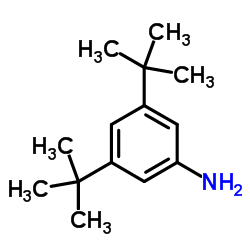
2380-36-1 |
| 文献:Surry, David S.; Buchwald, Stephen L. Journal of the American Chemical Society, 2007 , vol. 129, # 34 p. 10354 - 10355 |
|
~93% 
2380-36-1 |
| 文献:Roy, Nabarun; Lehn, Jean-Marie Chemistry - An Asian Journal, 2011 , vol. 6, # 9 p. 2419 - 2425 |
|
~10% 
2380-36-1 |
| 文献:Farmer, Luc J.; Marron, Kristen S.; Canan Koch, Stacie S.; Hwang; Kallel, E. Adam; Zhi, Lin; Nadzan, Alex M.; Robertson, Dave W.; Bennani, Youssef L. Bioorganic and Medicinal Chemistry Letters, 2006 , vol. 16, # 9 p. 2352 - 2356 |
|
~% 
2380-36-1 |
| 文献:Journal of Organic Chemistry, , vol. 49, # 4 p. 655 - 659 |
|
~% 
2380-36-1 |
| 文献:Revue Roumaine de Chimie, , vol. 37, # 11-12 p. 1335 - 1340 |
|
~% 
2380-36-1 |
| 文献:Revue Roumaine de Chimie, , vol. 37, # 11-12 p. 1335 - 1340 |


